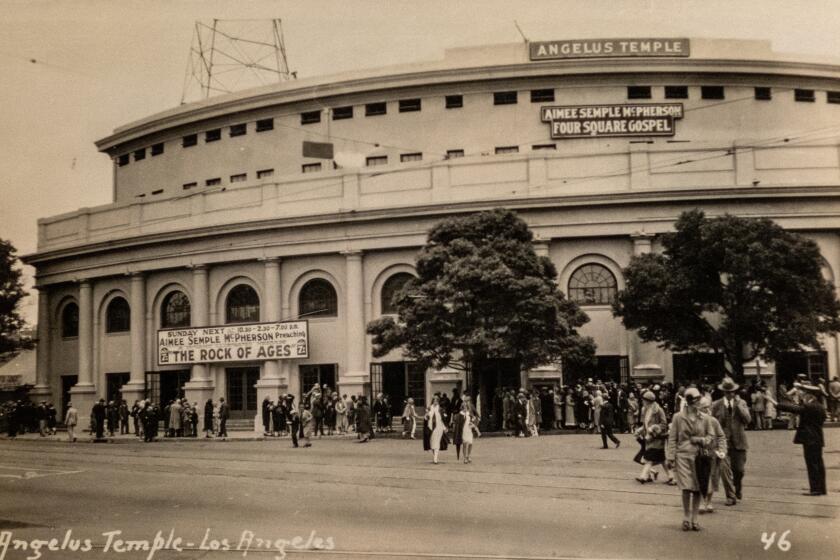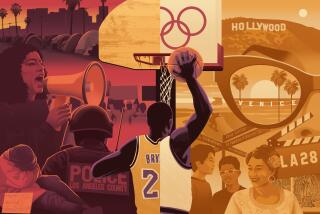
- Share via
Los Angeles has always been a city that prefers reinvention to tradition, making it the ideal incubator for new religious movements. From the beginning, its distance from the centers of institutional power made it a place where identity could be fluid, beliefs unusual and performance, a currency. Self-transformation was, for many, the ultimate goal.
“It is a young city, crude, wildly ambitious, growing,” wrote the critic Louis Adamic in the 1930s, with scathing insight. “It has halitosis and osmidrosis; and to kill the stench it gargles religious soul-wash and rubs holy toilet-water and scented talc between its toes.”
Scholars of religion have marveled at the city’s ability to create myriad new belief systems — from the Pentecostal revivals on Azusa Street in the early 1900s, to the Church of Scientology in the 1950s, to the wellness gospel of the 2000s and beyond. L.A. doesn’t just reflect spiritual trends — it manufactures them and exports them to the rest of the world.
Famed Evangelist Believed Victim of Heart Attack
Among L.A.’s self-realized religious innovators, Aimee Semple McPherson stands out. She is arguably our city’s founding godmother of reinvention. When she arrived in Los Angeles on Dec. 21, 1918, she was looking to channel her connection to the divine into what today we might call a platform. The “lady preacher” drove into town with only, as she would say time and again, “10 dollars and a tambourine.” In the backseat were her two young children, and riding shotgun was her mother, Minnie.
Claire Hoffman’s superb biography traces the life of Aimee Semple McPherson, a star preacher whose legacy lives on in L.A. despite a scandal-enshrouded disappearance in 1926.
McPherson had spent the last few years living hand to mouth, holding tent revivals across America centered on her Pentecostal gospel, and building a following of believers who saw the 28-year-old woman as touched by heavenly gifts. As she followed the voice of God, her mother served as the ballast to her spirit-filled wanderings, procuring money and supplies, mapping the road ahead and building a substantial subscriber base for their fledgling magazine, “The Bridal Call.” The two drove across the country’s new highways without a man to accompany them, a fact that would only add to McPherson’s mythology as a godly swashbuckling adventurer. As they cruised past orange groves and oil wells, Aimee was filled with dreams for the future — of sunshine, of easy living and of the multitudes who might come to see her preach. She would later write, “I had the feeling that here I would meet my destiny.”
Los Angeles in the 1920s was the perfect place for McPherson to build a following, fertile ground for radical ideas about how to connect God and self. It was not only one of the fastest-growing cities in the world but one of the fastest-growing cities in the history of the world. Unlike other American municipalities, L.A., it seemed, had erected itself through pure desire, a barren basin that stole enough water to reimagine itself as a paradise, whose city fathers marketed its sunny weather when they had little else to sell, cultivating its image as a healthy utopia, an alternative to grim, polluted industrialized East Coast cities. In the span of a few decades, it morphed from a violent outpost to one of the wealthiest places on the planet. To borrow a perfect analogy from historian Kevin Starr, Los Angeles was “the Great Gatsby of American cities.”
It would take McPherson just a few years to reach the heights of power in L.A. In 1923, she founded what is arguably America’s first megachurch, the Angelus Temple, which still welcomes believers on Glendale Boulevard, across from Echo Park Lake. Next, she started one of the first Christian radio stations, in 1924. At Angelus Temple, where the main auditorium seated more than 5,000, multiple services and other programming went on all day, every day, and her dazzling approach of combining theatrical spectacle with the gospel made her the precursor of the 20th century’s televangelists, a pioneer of Christian entertainment.
McPherson presented salvation through her legendary “illustrated sermons.” She rented costumes and scenery from nearby Hollywood studios and drew on popular culture and everyday events. She depicted life in Los Angeles as biblically prophesied and infused with meaning. Her critics called her the P.T. Barnum of Christianity. The temple had a 14-piece orchestra, a brass band and a hundred-voice choir, two-thirds female, all dressed in white. She used live camels, tigers, lambs, palm trees — whatever it took to bring biblical truth to life on her stage. The whole point was to dazzle and overwhelm. Aimee’s sermons were soon considered the best show in town. She was one of the first in the modern era to understand that faith, fame and spectacle were not contradictions, but a heady brew for success.
Readers respond to Patt Morrison’s recent piece on the L.A. landmarks that turn 100 this year, including Angelus Temple in Echo Park.
But despite her incredible ambition and achievements, McPherson became enshrouded in scandal. At the height of her fame, in 1926, she walked into the ocean at Venice Beach and vanished. Tens of thousands gathered on the sand to pray for her, two people died in the search effort, and the city’s headlines chronicled the tragedy like a soap opera. But 36 days later, Aimee wandered in from the deserts of Mexico to a backyard in Arizona telling an unbelievable story of being kidnapped.
She returned to Los Angeles, where she was soon prosecuted for making the whole thing up — along with her mother, an alleged lover and a schizophrenic look-alike female grifter who had been sleeping at Aimee’s parsonage. That fall, a judge listened to evidence on every aspect of McPherson’s life — from her business practices to her romantic life to the size of her ankles. The case was ultimately dropped, the mystery never solved, but through it all, McPherson kept preaching and growing her audience.
McPherson’s life, gospel and showmanship burnished a sales pitch that remains at the center of L.A.’s allure. Even as the city navigates its recovery from devastating natural disasters, it is still a place where people arrive with hopes of revival, of materializing their dreams, of second chances and spiritual, physical, material and mental transformation. Now as then, seekers are manifesting their dreams: There’s a better you available in the City of Angels.
Claire Hoffman is the author of a just-published biography of Aimee Semple McPherson, “Sister, Sinner.”
More to Read
A cure for the common opinion
Get thought-provoking perspectives with our weekly newsletter.
You may occasionally receive promotional content from the Los Angeles Times.








